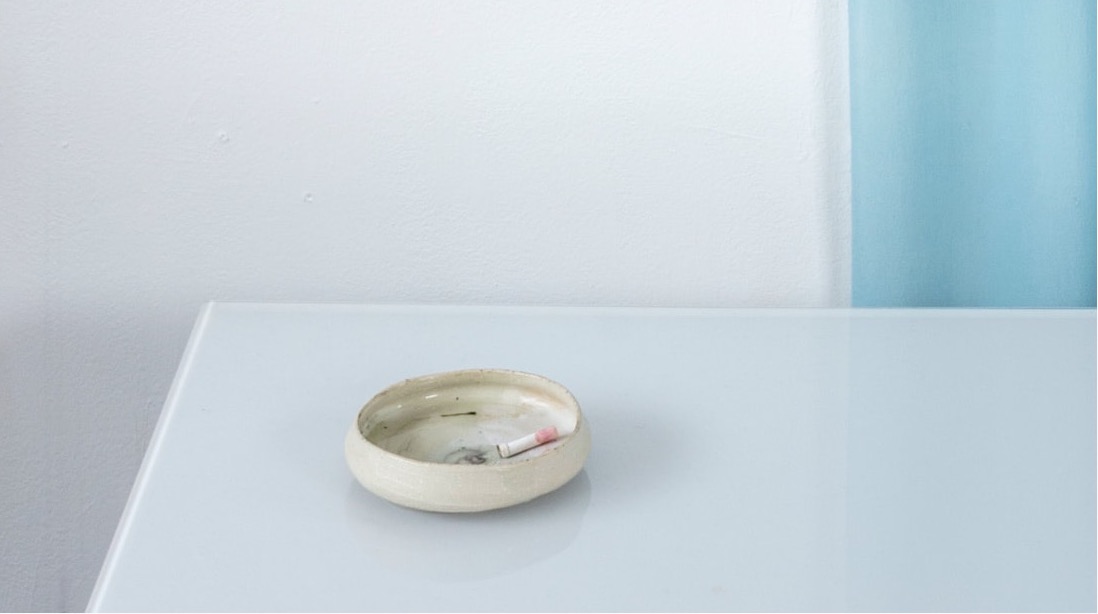‘When a day that you happen to know is Wednesday starts off sounding like Sunday, there is something seriously wrong somewhere.’
John Wyndham’s Day of the Triffids, 1951.
Episode 5, Day of the Triffids: a light in the night, describes an apocalyptic London, where everyone has been blinded by poisonous venom, spat by an army of man-eating plants, the Triffids. The protagonists Bill and Josella, some of the only sighted people left, seek refuge in an elegant abandoned apartment, Josella dressed in a blue silk georgette dress, smokes a cigarette, whilst Bill sips a fine brandy — they witness a suicide pact by a neighbouring couple, hear cries of people below and watch London burn.
Copperfield, London presents Blindspot, Jane Bustin’s second solo exhibition with the gallery, including collaborations with writers Tracy Chevalier, John Hull and furniture maker Ed Johnson.
Combining, painting, textile, ceramic and sculpture, these works question the trust we place in our primary senses when attempting to perceive, in particular what it is ‘to see’.
In our current times, trusting what is presented as fact is no longer enough. What can we turn to — an analysis of all senses, a gut feeling?
On the evening of Tuesday 19th May 1942, the BBC sound recording team were in a Surrey garden to transmit a live recording: the song of the Nightingale. A few minutes in, the recording is disturbed by the unexpected drones of 197 British RAF bombers on their way to devastate Mannheim in Germany. The BBC continued the recording.
The installation, Woodsong, plays this recording alongsid five oak panels. The dimensions and colour of each panel correspond to the wingspan and appearance of five British songbirds; their positioning on the wall, reminiscent of the popular 1950s flying ducks which were a decoration in many working class households. Nearer the floor are a row of blank papers with bird names embossed in Braille, made from aged glycerin paper. These papers previously protected the surfaces of hand illustrations in a red cloth bound copy of, British Birds by W. H. Hudson, published in 1902 in the age of innocence.
Collaborating with the writer Tracy Chevalier and writer and blind theologian John Hull, Chevalier translated the effects of this series of paintings into words, as a means of making them visible to John Hull. Chevalier’s text acted as a basis for Hull to respond to the initial paintings. Bustin completed the collaboration by making a series of paintings that conceptualised Hull’s poetic perceptions. One of these works is titled Breaststroke.
Having lost all visual memory, Hull said, “Jane, you have to understand that when you say to me the colour red, it means nothing to me”. John described himself as a ‘whole body seer’
The loss of sight leaves us with sound and touch, the sound of the songbird, the stroke of the breast, the feeling of silk georgette passing between your fingertips and the lightness of smoke exhaled curling around the heat of our cheeks. Even as London burns.
| Duration | 13 November 2019 - 20 December 2019 |
| Times | Wednesday - Saturday, 12 - 6pm |
| Cost | Free |
| Venue | Copperfield |
| Address | 6 Copperfield Street, London, SE1 OEP |
| Contact | 07845 594 549 / info@copperfieldgallery.com / www.copperfieldgallery.com |

